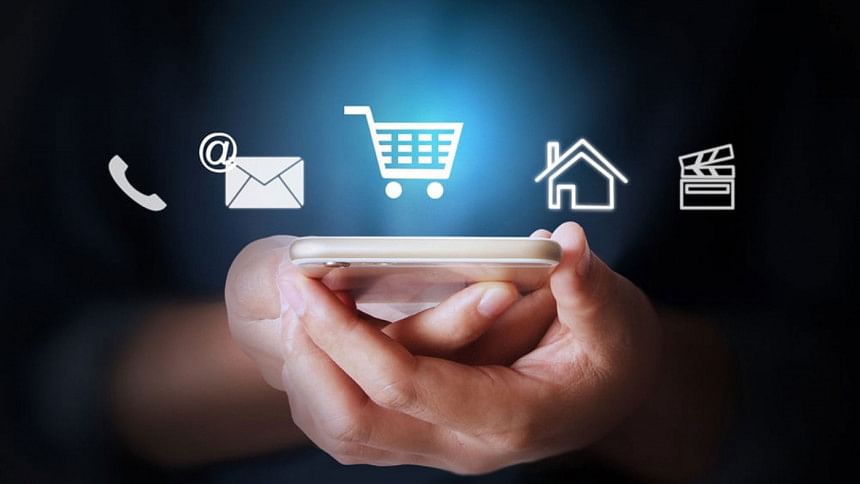Six payment trends to watch out for in 2021

This year has been like no other for digital payments. Even as economies came to a standstill, consumers pivoted to online shopping and businesses turned to remote delivery and digital acceptance. The pandemic-fuelled adoption of all things digital and uncovered distinct possibilities in consumer and business behaviour. Consumers formed brand new habits—using digital technology for work, working from home, and ordering online. Here are six trends that could shape digital payments in Bangladesh in 2021.
Mainstream emergence of integrated commerce
In early 2020, digital took centre-stage as many offline and neighbourhood stores closed and some pivoted to remote delivery. As the economy opened slowly, businesses started implementing new methods like buying online. With 96 million internet subscribers, a cohort of first-time e-commerce shoppers emerged as shoppers started depending on stores that have an online presence.
2021 will see further evolution in this behaviour; especially with ecommerce in Bangladesh expected to touch USD 3 billion by 2023. Integrated commerce will not remain a fad but become commonplace with new-age distribution channels and market aggregators inserting themselves into the value chain. To provide seamless shopping experiences, businesses will become nimbler by focusing on app-centred buyers and a multi-channel strategy for consumers shopping online, in-app and in stores. Omni-channel commerce will come of age in 2021.
Rise of pay later
Since the lockdown restrictions came into place, there has been a 50 percent month-on-month growth in credit cards transactions in Bangladesh—indicating the vast opportunity in consumer credit. The acceleration to digital-first experiences changed consumer expectations on how and when they pay. With personal and discretionary expenditures plummeting, affordability has become a central theme, leading to businesses and consumers welcoming Buy Now Pay Later (BNPL) options, injecting speed, flexibility and convenience in paying. The coming year will witness the explosion of mass affordability solutions triggered by BNPL options offered by merchants, manufacturers, marketplaces and, of course, Banks and Fintechs.
Contactless future
This year, in more ways than one, was about "contactless". People used contactless cards and QR code payments due to safety concerns, leading to an uptick in contactless payments in high footfall segments like grocery.
Besides the safety, speed and convenience of contactless cards, the central bank's decision to increase contactless payment limits to Tk 5,000 is opportune, as it expands the category of purchases which can be made by tap and pay mode, likely to be quick service restaurants, dining, fuel, supermarkets and pharmacies, and brand new categories like Transit and Tolls could go contactless. And as people get familiar with scanning QR codes, consumers will pay in multiple ways without making contact at merchant locations.
MSMEs to embrace digitisation
In 2020 MSMEs increasingly adopted digitisation as the year drastically altered the way businesses operate—to source materials, pay employees or accept customer payments. In 2021, small business owners will continue to look for ways to stay connected to consumers and leverage digital marketplaces. This will help gain exposure to new segments, secure new leads, provide 24/7 access to products and create experiences for digital-first customers. Increased digital MSME footprint will open the gates to MSME credit going mainstream in 2021.
The mobile phone as an Acceptance Device
This year, many "offline" merchants especially in unorganised retail embraced digitisation and will reap its benefits over the coming years. Further aided by smartphone ubiquity, contactless payments—both QR and NFC led—is set to become the default payment experience at point of sale in 2021.
The advent of "Tap to Phone" will enable small businesses to enter the digital economy with an app on their existing smartphones, so merchants can accept contactless payments without investing in an acceptance terminal. 2021 is expected to see accelerated usage of contactless payments and Tap to Phone could be the catalyst. Expect a flurry of Fintech and Payment Facilitators entering the arena riding off this, in 2021.
No compromise on security
World Economic Forum's Global Risks Report 2020 pegs cyber-attacks to garner data/money amongst the top risks that businesses are likely to face in coming years. As businesses and consumers adopt digital payments, fraudsters too are getting smarter, putting payment security back in the spotlight. It will be crucial to consider checkout experiences and fraud activities, particularly with Card Not Present transactions, from the lens of payment security. Given the shift to online-first offerings, investments in cybersecurity and authentication will take precedence, especially for small businesses that are not as equipped to handle fraud as big firms. Redoubling business commitment to security will catalyse innovation in payment security. For our nascent digital payments journey to mature in 2021, a continued focus on Risk and Cybersecurity to protect consumers and keep fraudsters at bay is an area all of us in the payments industry have to be vigilant about.
Soumya Basu is Senior Director, Business Development, South Asia, Visa.

 For all latest news, follow The Daily Star's Google News channel.
For all latest news, follow The Daily Star's Google News channel. 



Comments